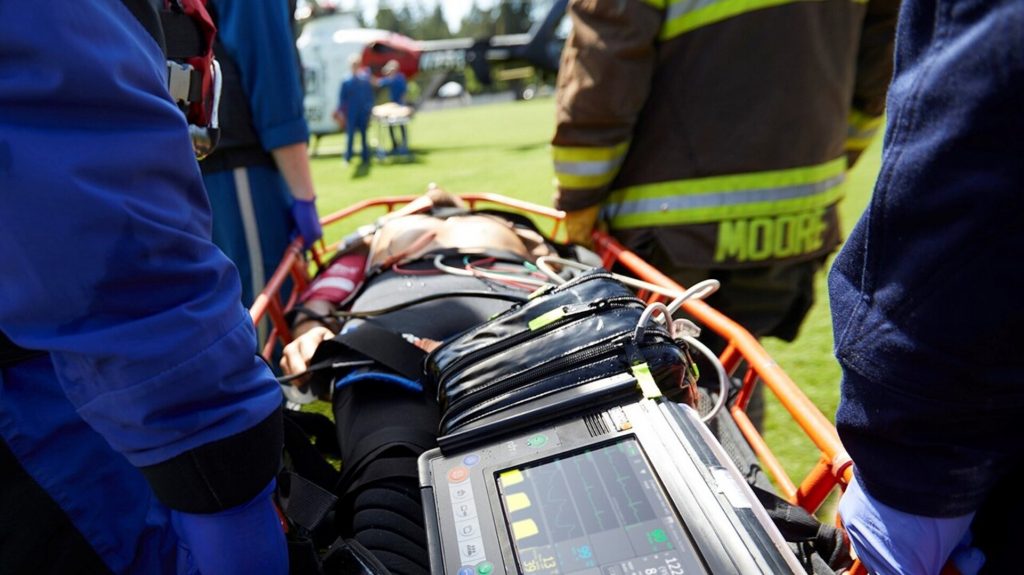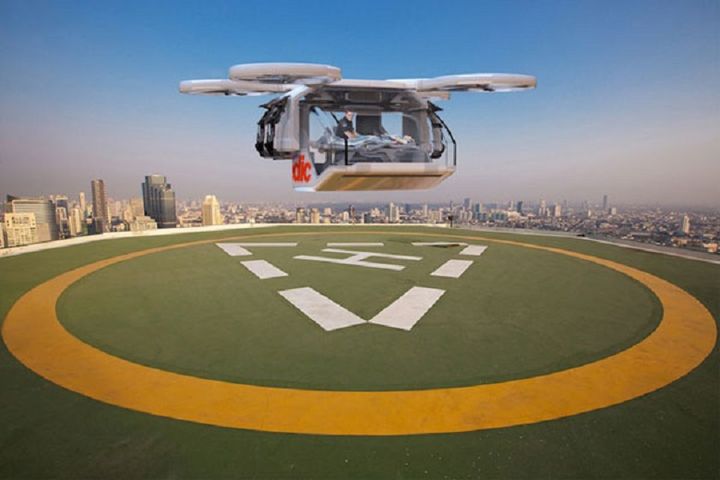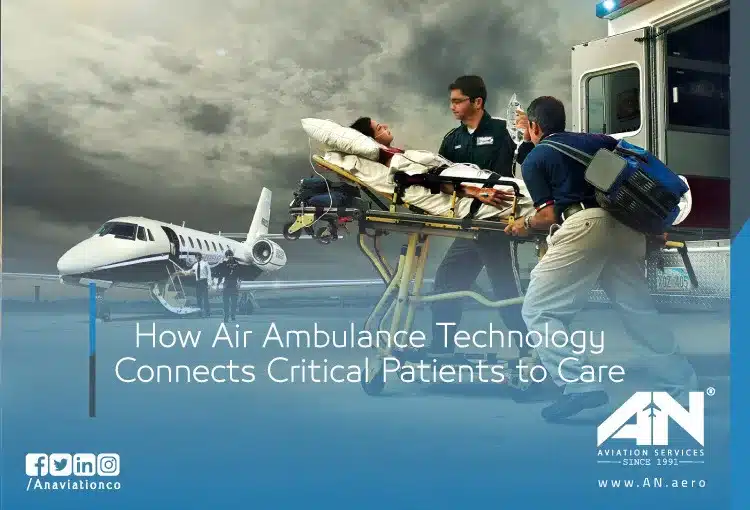Today, let’s talk about something truly out of this world: the impact of space technology on air ambulance services. Believe it or not, space technology has paved the way for some amazing advancements in the field of air ambulances. When we think of space, we often picture astronauts floating around in zero gravity, but did you know that the same technologies used in space exploration are now being used to save lives right here on Earth? It’s mind-blowing, and it’s revolutionizing the way we provide emergency medical care to those in need. So, buckle up and get ready for an enlightening journey into the exciting world where space technology meets air ambulance services.

Advancements in Satellite Communication
In recent years, satellite communication has made significant advancements, revolutionizing various industries, including air ambulance services. These improvements in communication systems have greatly enhanced the efficiency and effectiveness of air ambulance operations.
Improved Communication Systems
Satellite communication technology has enabled seamless and reliable communication between air ambulances, ground teams, and medical facilities. The use of satellite networks ensures that there is constant connectivity even in remote or inaccessible areas, allowing for real-time monitoring, coordination, and assistance.
Gone are the days when air ambulance crews had limited means of communication, relying solely on radio signals that often had weak reception or were prone to interference. With advancements in satellite communication, air ambulance crews can now stay in constant contact with medical professionals on the ground, providing live updates on the patient’s condition and receiving valuable medical guidance.
Real-Time Monitoring and Assistance
Satellite communication systems have also facilitated real-time monitoring of air ambulance operations. By equipping air ambulances with advanced sensors and instruments, medical teams can closely monitor the patient’s vital signs, ensuring timely interventions and adjustments to the medical care being provided.
Moreover, satellite technology allows for immediate consultation with medical experts who can remotely analyze medical data and provide valuable insights or recommendations. This real-time assistance greatly enhances the level of care provided to patients during air ambulance transfers, ensuring that they receive the utmost medical attention and support throughout their journey.
Enhanced Navigation Systems
Accurate and precise navigation is paramount in air ambulance services. Satellites have played a crucial role in advancing navigation systems, making air ambulance flights safer and more efficient.
GPS Technology for Precise Navigation
Global Positioning System (GPS) technology has become an indispensable tool for air ambulance services. By relying on a network of satellites, air ambulances can accurately determine their position and navigate through the skies with unparalleled precision.
GPS technology provides real-time information on the aircraft’s altitude, speed, and trajectory, enabling pilots to navigate through complex airspace and avoid potential collisions with other aircraft. This precise navigation capability is particularly crucial during emergency medical transfers, where every second counts.
Avoidance of Air Traffic and Dangerous Weather Conditions
Another significant benefit of satellite technology in air ambulance services is the ability to avoid air traffic congestion and dangerous weather conditions. Satellites provide up-to-date information on air traffic patterns and weather forecasts, allowing air ambulance crews to plan their routes accordingly.
By rerouting the flight path to avoid congested areas or severe weather conditions, air ambulance crews can optimize the efficiency of their operations while ensuring the safety of both the patient and the crew. This proactive approach to navigation significantly reduces the risk of delays and enhances the overall patient care experience.

Tracking and Remote Sensing
Accurate and efficient tracking of air ambulances is crucial for effective management and coordination of resources. Satellite technology has revolutionized the tracking capabilities of air ambulance services, ensuring optimal utilization of resources and timely assistance.
Better Tracking of Air Ambulances
Satellite tracking systems allow for real-time monitoring of air ambulance locations, enabling ground teams and medical facilities to track the exact position and progress of the aircraft. This information is essential for efficient resource allocation, ensuring that the nearest available air ambulance is dispatched to the scene of an emergency.
With the ability to track multiple air ambulances simultaneously, satellite technology enhances operational coordination, reducing response times and increasing the chances of successful patient outcomes.
Identification of Optimal Landing Sites
Remote sensing technology, enabled by satellites, has also played a vital role in identifying optimal landing sites for air ambulances. Satellites equipped with high-resolution cameras and sensors can capture detailed images and data of potential landing areas, allowing air ambulance crews to assess the suitability and safety of landing sites before arrival.
By analyzing factors such as terrain, obstacles, and weather conditions, air ambulance crews can make informed decisions regarding the selection of landing sites. This capability ensures that patients are transported to the most suitable and accessible locations, minimizing the time and effort required for ground transportation.
Weather Forecasting and Remote Sensing
Accurate weather forecasting is crucial for air ambulance operations, as adverse weather conditions can pose significant risks to both the aircraft and the patient. Satellites have greatly enhanced weather monitoring and remote sensing capabilities, providing air ambulance services with valuable insights for safe flight planning.
Accurate Weather Monitoring
Satellites equipped with advanced weather monitoring instruments can provide air ambulance crews with real-time updates on changing weather conditions. From detecting thunderstorms and strong winds to monitoring rainfall and visibility, satellites offer a comprehensive understanding of the atmospheric conditions along the flight path.
This accurate weather monitoring enables air ambulance crews to make informed decisions regarding the timing and route of their flights. By avoiding areas experiencing severe weather conditions, air ambulances can ensure the safety and well-being of the patients they transport.
Identification of Safe Flight Paths
Satellites also play a crucial role in the identification of safe flight paths for air ambulances. By analyzing weather data and atmospheric conditions, satellites can provide insights into the most favorable routes for air ambulance operations.
Identifying safe flight paths allows air ambulance crews to optimize their routes, reducing the risk of encountering adverse weather conditions or areas of restricted airspace. This proactive approach to flight planning ensures the timely and safe transportation of patients, even in challenging weather conditions.

Telemedicine and Teleconsultation
The integration of satellite technology with telemedicine has revolutionized air ambulance services, enabling remote medical consultations and enhancing emergency medical care during flight transfers.
Remote Medical Consultations
Satellite communication systems facilitate remote medical consultations between air ambulance crews and medical experts located at ground facilities. Through live video conferencing and data transmission, medical professionals can assess the condition of the patient in real-time and provide immediate guidance or interventions.
This remote consultation capability is particularly valuable in critical medical situations where quick decision-making and expert opinions are essential. By leveraging satellite technology, air ambulance crews can access specialized medical expertise, ensuring the highest level of care for their patients throughout the journey.
Enhanced Emergency Medical Care
Satellite technology has also paved the way for enhanced emergency medical care during air ambulance transfers. By equipping air ambulances with advanced medical equipment and technologies, such as telemonitoring devices and remote-controlled robotic systems, medical professionals can provide specialized care even at high altitudes.
Real-time vital sign monitoring, medication administration, and advanced life support systems are just a few examples of the medical innovations made possible by satellite technology. These advancements have significantly improved the ability of air ambulance crews to provide timely and effective medical interventions, ultimately saving lives during critical emergencies.
Improved Equipment and Technologies
Satellite technology has not only improved communication and navigation systems but also paved the way for innovations in air ambulance equipment and technologies, further enhancing the quality of care provided to patients.
Medical Innovations for In-Flight Care
Satellite technology has enabled the development of specialized medical equipment designed specifically for air ambulance services. From compact and lightweight patient monitoring devices to portable diagnostic imaging systems, these innovations ensure that medical professionals have the necessary tools to provide comprehensive care during flight transfers.
With the integration of satellite communication systems, these medical innovations can seamlessly transmit medical data and images to ground facilities, allowing for remote analysis and consultations. This real-time information exchange enhances the decision-making process and supports accurate medical interventions.
Advanced Life Support Systems
Satellites have played a crucial role in advancing life support systems used in air ambulances. By linking life support equipment to satellite communication networks, medical professionals can remotely monitor and control critical systems, ensuring the stability and well-being of the patient throughout the journey.
From automated defibrillators and ventilators to advanced medication delivery systems, these life support innovations have significantly improved the chances of survival for patients in critical condition. The integration of satellite technology ensures that these systems operate seamlessly, allowing for continuous monitoring and adjustment, even in challenging airborne environments.

Drones and Unmanned Aerial Vehicles (UAVs)
The emergence of drones and unmanned aerial vehicles (UAVs) has revolutionized the delivery of medical supplies and rapid response capabilities in air ambulance services. Satellite technology plays a vital role in enabling the efficient and effective use of these unmanned platforms.
Delivery of Medical Supplies and Equipment
Drones equipped with satellite communication systems can be utilized to deliver essential medical supplies and equipment to remote or inaccessible areas. By leveraging satellite networks, drones can autonomously navigate through challenging terrains and deliver critical supplies, such as medications, blood products, and medical equipment, to areas where traditional transportation may be difficult or time-consuming.
This innovative approach to supply delivery significantly reduces response times, ensuring that patients in remote or crisis-stricken areas receive the necessary medical resources promptly. Moreover, the use of drones minimizes the risk of human error or delays associated with conventional transportation methods.
Rapid Response in Remote or Inaccessible Areas
Satellite technology enables the rapid response capabilities of drones and UAVs in remote or inaccessible areas. By utilizing satellite communication networks, air ambulance services can remotely control and monitor the movements of these unmanned platforms, ensuring safe and efficient operations.
In emergency situations where immediate medical attention is required, drones can be deployed quickly to assess the situation, provide initial medical care, or transport essential medical equipment. This rapid response capability greatly enhances the effectiveness of air ambulance services, particularly in regions with limited infrastructure or challenging terrain.
Reduced Response Time and Increased Efficiency
Satellite technology has significantly contributed to reducing response time and increasing the overall efficiency of air ambulance services. By streamlining communication, navigation, and resource management, satellite-enabled systems ensure a seamless and timely patient transfer process.
Faster Patient Transfer and Evacuation
With real-time communication and precise navigation systems enabled by satellite technology, air ambulance services can transfer patients in a faster and more efficient manner. Constant connectivity between air ambulances, ground teams, and medical facilities allows for smooth coordination, minimizing delays and optimizing the transfer process.
In critical medical situations where every moment matters, reduced response times can be life-saving. By leveraging satellite technology, air ambulance services can ensure that patients reach the appropriate medical facilities promptly, increasing the chances of positive medical outcomes.
Improved Coordination between Ground and Air Teams
Satellite communication systems have significantly improved the coordination between ground and air teams in air ambulance services. Real-time updates, including patient information, medical data, and flight progress, can be seamlessly transmitted between the various stakeholders involved in the transfer process.
This improved coordination enables ground teams to prepare for the arrival of patients, ensuring the availability of necessary medical resources and personnel. It also allows medical facilities to streamline their admission processes, ensuring a smooth transition for patients transferring from air ambulances.

Space Technology for Air Crash Investigation
The utilization of space technology, including satellite imagery and data analysis, has brought significant advancements to air crash investigation techniques. By leveraging satellite capabilities, investigators can enhance accident site mapping and aid in accident reconstruction.
Enhanced Accident Site Mapping
Satellites equipped with high-resolution cameras and sensors can capture detailed images of accident sites, providing investigators with valuable insights into the circumstances surrounding the crash. These satellite images help create accurate maps of the crash site, documenting crucial evidence and facilitating the investigation process.
Accident site mapping enabled by space technology plays a vital role in understanding the dynamics of the crash, assisting investigators in determining the root causes and contributing factors. By analyzing satellite imagery, investigators can reconstruct the sequence of events leading to the accident, ultimately promoting aviation safety improvements.
Aid in Accident Reconstruction
Satellite technology also aids in accident reconstruction, further supporting the investigation process. By analyzing satellite data, including weather patterns, flight path information, and air traffic data, investigators can gain a comprehensive understanding of the events preceding the crash.
Space-based technologies enable investigators to piece together the puzzle and identify potential contributing factors, such as adverse weather conditions, communication breakdowns, or air traffic congestion. This information assists regulatory bodies and aviation authorities in implementing necessary safety measures and improving air ambulance services’ overall reliability.
Predictive Analysis and Data Management
Satellite technology, coupled with advanced data management systems, has enabled predictive analysis in air ambulance services. By processing vast amounts of data and identifying hotspots and high-risk areas, satellite-enabled systems optimize resources and services.
Identification of Hotspots and High-Risk Areas
Satellite imagery and data analysis can identify hotspots and high-risk areas where emergency medical services, including air ambulances, are most frequently required. By assessing historical data, population density, transport infrastructure, and other relevant factors, predictive analysis can identify regions where the demand for air ambulance services is more likely to occur.
This proactive approach allows air ambulance services to strategically plan their operations, ensuring the availability of resources in areas of high demand. By optimizing resource allocation based on predictive analysis, air ambulance services can operate in a more efficient and cost-effective manner, ultimately benefiting patients in need of immediate medical care.
Optimization of Resources and Services
Satellite-enabled data management systems play a vital role in optimizing resources and services in air ambulance operations. By efficiently collecting, analyzing, and utilizing data on patient demographics, medical conditions, and service utilization, air ambulance services can tailor their operations to meet specific needs.
Through data-driven decision-making, air ambulance services can optimize their fleet deployment, crew scheduling, and resource allocation, ensuring timely and reliable services to the communities they serve. This data-centric approach enhances operational efficiency, ultimately leading to improved patient outcomes and satisfaction.
In conclusion, the advancements in satellite technology have brought about a significant transformation in air ambulance services. From improved communication systems and enhanced navigation capabilities to remote sensing and telemedicine, satellites have revolutionized every aspect of air ambulance operations.
By leveraging satellite-enabled systems, air ambulance services can provide faster and more efficient patient transfers, ensure real-time monitoring and assistance, and enhance the overall quality of emergency medical care. Additionally, satellite technology plays a crucial role in accident investigations, predictive analysis, and resource optimization, further improving the reliability and effectiveness of air ambulance services.
As space technology continues to evolve, we can expect further advancements and innovations in air ambulance services, ultimately saving more lives and bringing aid to those in need, even in the most challenging and remote locations.



